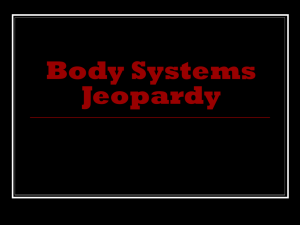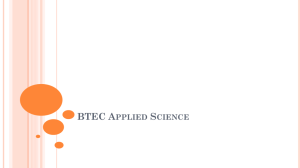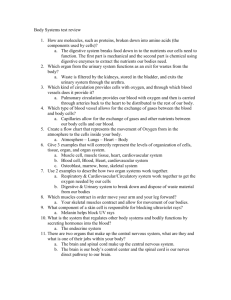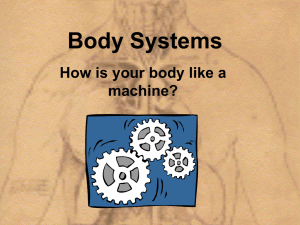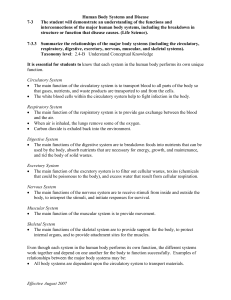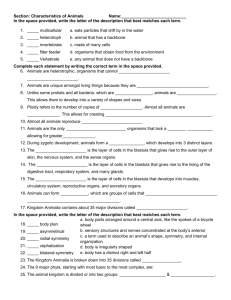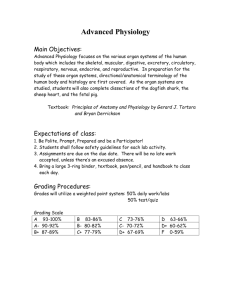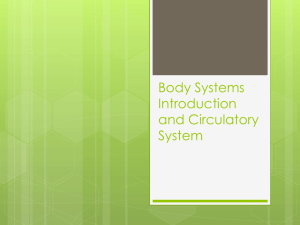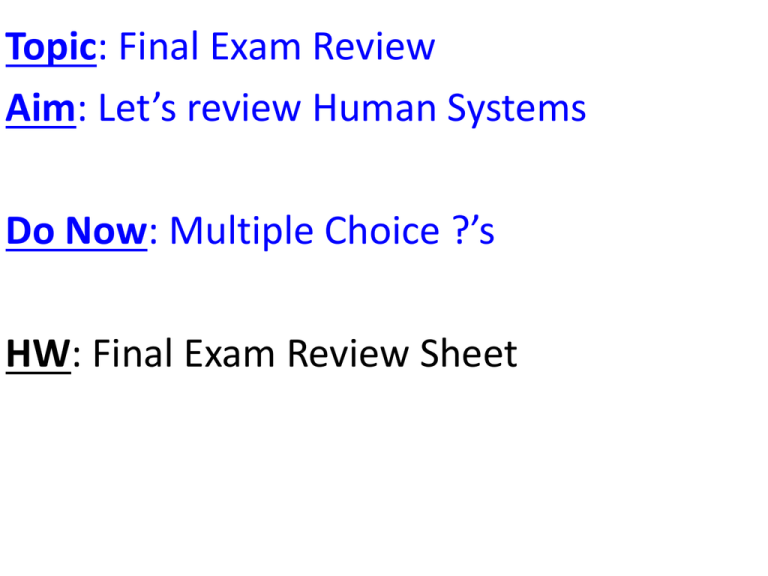
Topic: Final Exam Review
Aim: Let’s review Human Systems
Do Now: Multiple Choice ?’s
HW: Final Exam Review Sheet
Which diagram below represents one type
of human tissue? (The diagrams are not
drawn to scale.)
Three different human cells are shown below.
Which process occurs in all of these cells?
1. metamorphosis 2. locomotion
3. reproduction
4. photosynthesis
All plants and animals have
mechanisms that
(1) transport nutrients
(2) perform photosynthesis
(3) regulate nerves
(4) produce flowers
The basic life functions of an organism are
carried on by
(1) cells
(2) atoms
(3) nutrients
(4) hormones
Which term identifies a group of cells that
work together to perform a similar
function?
(1)molecule
(2) organism
(3) organ
(4) tissue
Which substance do all living things
require to survive?
(1)blood
(2) carbon dioxide
(3) water
(4) organic soil
One important difference between living
things and nonliving things is that only
living things have
(1)compounds
(2) molecules
(3) elements
(4) cells
In order to survive, all organisms must
have
(1)chlorophyll
(2) energy
(3) carbon dioxide
(4) blood
The sum of all chemical reactions that take
place within an organism is known as
(1) evolution
(2) circulation
(3) metabolism
(4) reproduction
During which process do cells use oxygen
to release stored energy?
(1) photosynthesis
(2) circulation
(3) respiration
(4) digestion
Which term describes an organism’s ability
to maintain a stable internal environment?
(1)reproduction
(2) locomotion
(3) extinction
(4) regulation
What system is represented in the diagram?
What system is represented in the diagram?
A
B
C
D
E
F
G
H
1. Identify the following
information for the
food to the left.
a. Serving size
b. Total carbohydrates
c. Calories
d. Protein
e. Calories from fat
2. How many calories
would you consume
if you ate 2 servings
of these crackers?
1.What system is represented in the diagram?
2. Identify structures C, G, E and D.
Identify each structure in the diagram and describe its
function.
1. What pathogen causes AIDS?
HIV (which is a virus)
2. What is the effect of AIDS on the body?
It weakens the immune system so the
body cannot fight pathogens well.
white
blood cell
Y
red blood cell
Identify structures X, Y, and Z.
Z
platelet
A
B
C
D
E
Insulin and glucagon are hormones that affect blood
sugar levels. The diagram below shows the feedback
system used by the human body to increase and
decrease blood sugar levels.
This feedback system is one way that the human body
(1) circulates gases
(3) destroys viruses
(2) maintains equilibrium (4) transports nutrients
The diagram below shows a human organ
system.
Which human organ system is shown?
(1) nervous
(3) circulatory
(2) digestive
(4) respiratory
The diagram below shows part of the human
Excretory system.
The structures shown are primarily involved in
(1) transporting blood (3) removing wastes
(2) producing sex cells (4) breaking down food
Which health condition is an infectious
disease?
(1) pneumonia caused by microorganisms
(2) heart problem caused by a high-fat diet
(3) lung cancer caused by smoking
(4) eye damage caused by ultraviolet light
Infections may be caused by
(1)mutations
(2) toxic substances
(3) microorganisms
(4) climate changes
The main function of hormones in the
human body is to
(1) identify and destroy microbes
(2) regulate body functions
(3) transport blood to cells
(4) store energy
Which human organ system produces
sperm or egg cells?
(1)digestive system
(2) respiratory system
(3) nervous system
(4) reproductive system
A student fails to eat a balanced diet over a
period of time. This lack of a balanced diet
can lead to
(1)selective breeding
(2) extinction
(3) dynamic equilibrium
(4) disease
Which human organ system eliminates
liquid and gaseous wastes from the body?
(1) circulatory
(2) excretory
(3) endocrine
(4) reproductive
Which human organ system produces
hormones to regulate growth,
development, and reproduction?
(1)circulatory
(2) nervous
(3) digestive
(4) endocrine
The interaction of the skeletal and
muscular systems to produce locomotion is
coordinated by which human body system?
(1)circulatory
(2) nervous
(3) excretory
(4) respiratory
The chart below identifies the function of several
organs found in a human body system.
Which human body system performs these
functions?
(1) skeletal
(3) circulatory
(2) digestive (4) respiratory
In humans, the amount of sugar in blood is
controlled by the release of a hormone
called insulin. This process is an example of
(1)depletion
(3) regulation
(2) digestion
(4) excretion
Scurvy is a disease that sailors often got on
long voyages. It was discovered that scurvy
could be prevented by eating oranges and
lemons. This suggests that scurvy is a disease
caused by
(1)exposure to sea air
(2) a microorganism
(3) a nutritional deficiency
(4) lack of exercise
A cat jumps when startled by a loud noise. This
is an example of an organism
(1) sensing and responding to its external
environment
(2) sensing and responding to its internal
environment
(3) changing and controlling its external
environment
(4) changing and controlling its internal
environment
Running to escape danger is an action that
requires the nervous system to coordinate
the interaction of which two body systems?
(1) digestive and endocrine
(2) muscular and skeletal
(3) reproductive and excretory
(4) circulatory and digestive
Which unit is used to express the amount
of energy in food?
(1)Calorie
(2) milliliter
(3) degree Celsius
(4) gram



